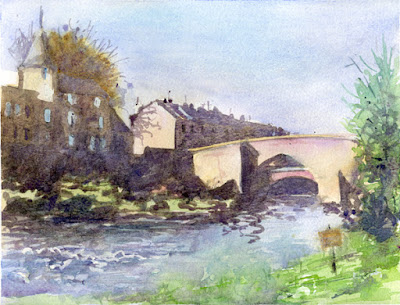Have you ever wondered what sizing was all about? I attended a session at a local art association meeting recently where the topic was paper and included watercolour paper and sizing. So I’ll try to transmit what I’ve learned in a simplified fashion.
Why should we learn about sizing and how it can affect your preference for wetting your paper for stretching?
First, what is sizing? Sizing is a gelatin added to your watercolor paper during the manufacturing process. Manufacturers of good papers include it in the pulp before pressing, while others also add it to the outside layers of the paper.
So what does sizing do for us? It controls the absorbency of the paper. Since most papers are made out of cotton and many are 100% cotton, without sizing the paper would be very absorbent - maybe too absorbent. That would translate into the paint/colours being "swallowed" by the paper. If the paint would be absorbed immediately, without sizing, you not be able to push the paint around. Sizing allows you to control your paint. Bottom line - gelatin makes the paper less absorbent and helps you control the paint on the paper and make even washes.
Absorbency affects how vibrant the colours looks. More sizing keeps the paint on top of the paper which make your paintings more brilliant. Some people reduce the sizing and this practice results in the paint seeming to disappear. Actually, the paint just goes deeper into the paper fibers hence the increased lightening of colours as the paint dries
I remember a discussion at a recent workshop where some participants were talking about the unevenness of sizing with some papers. Uneven sizing can cause dark spots when the paint soaks into the paper. Imagine working on a sky and having unexplained blotches in your sky – regardless of your most skilled paint strokes. Luckily, my favorite brand of paper, Fabriano, had no reported incident of uneven sizing.
One needs to make some choices before applying paint to paper. Should you want more absorbency, you lessen the sizing. On the other hand, if you want less absorbency, you keep the sizing.
In addition to soaking the paper to stretch it, some do it to lessen the sizing of the paper. To get the desired amount of sizing, the correct timing for the soaking takes practice. One of the dangers of soaking the paper too long is that too much soaking can move the sizing to make an uneven absorbent surface. Spots where there are increased sizing will resist the paint placed on it. Someone once reported that spots are less likely to happen when the paper is wet by running water than by soaking. with this method, there is no chance for the displaced sizing to stay in one place and make spots.
Remember, there is still sizing mixed in with the paper pulp itself so the sizing is not gone completely.
Other practices that remove sizing include using the Magic Sponge. If you've ever used it, you know you can get to the white of the paper but then the paper behaves differently - that's the lack of sizing on the surface. There is also scrubbing your paper with a stiff brush to lift paint.
Other things I've heard but have not been able to nail down is how sizing on older paper behaves. I've read anecdotes of the sizing not behaving well.
Should you wish for a more comprehensive explanation, you'll find a lot of more technical information available online. Here are a few:
This week's art find is Hannie Rieuwerts:
Have a great week,
Danielle



























